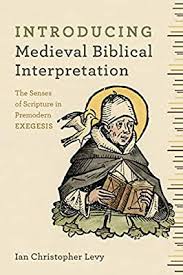
Here’s a very short (350 words) review of Ian Christopher Levy’s book Introducing Medieval Biblical Interpretation (Baker, 2018). The review just came out in the Jan 2020 issue of Interpretation: A Journal of Bible and Theology.
My Torrey colleague Greg Peters endorsed the book with this back-cover blurb: “Levy has taken a vast amount of information that often is available only to the specialist and made it easily and enjoyably accessible to non-experts. For those unfamiliar with medieval biblical interpretation, this volume is a readable yet rich introduction to the topic. It lays out the broad trajectory of medieval biblical interpretation and demonstrates its relevance for the Christian church today.”
Here’s my review:
This volume introduces the thought of key interpreters of Scripture from nearly a millennium of Western intellectual history. Though there is a brief opening overview of church fathers reaching back to Origen, Levy’s real tale picks up with Bede the Venerable in the seventh century and concludes with Jean Gerson in the fifteenth.
The book does not attempt to be exhaustive either in its catalog of interpreters or in its account of their oeuvres, relying instead on a strategy of carefully selecting figures who are representative, influential, and acknowledged as masters of their arts, and then providing sample examinations of their key works. Levy says that “the continuity inherent in this sacred tradition proved to be an internal guide” (p. xi) to which authors and texts should be included.
While the focus is on figures and texts, made present in generous quotations which allow readers to encounter the medieval voices directly, Levy’s historical narration also remains alert to the rise and fall of movements and schools of thought. He charts the Glossa Ordinaria’s rise to dominance, for example; consistently notes the distinction between monastic and scholastic settings; and traces the emergence of new interpretive techniques.
There are notable themes that traverse the entire book (the senses of Scripture is prominent); but Levy does not press any grand narrative onto the material. Levy is a clear and engaging writer, constantly aware of the needs of his readers. Writing for “an age dominated by the historical-critical method” (p. 1), Levy seeks to commend “the fecundity of meaning to be discovered through the techniques of medieval hermeneutics” (p. 3). He does not conceal the theological presuppositions of these pre-modern interpreters: they came to the sacred text expecting that the living God who authored it would use it to draw them into sanctifying communion.
Paraphrasing Nicholas of Lyra, Levy suggests that this affective engagement with Scripture manifests a “hermeneutics of sanctity” (p. 233) in which the good reader consents to be transformed by God’s word. Intentionally heavy on exposition and light on hermeneutical theory (there is a smattering of Gadamer in the conclusion), the strength of Introducing Medieval Biblical Interpretation is that it leads readers into an entire epoch of exegesis, delivering impressively on the promise of its title.